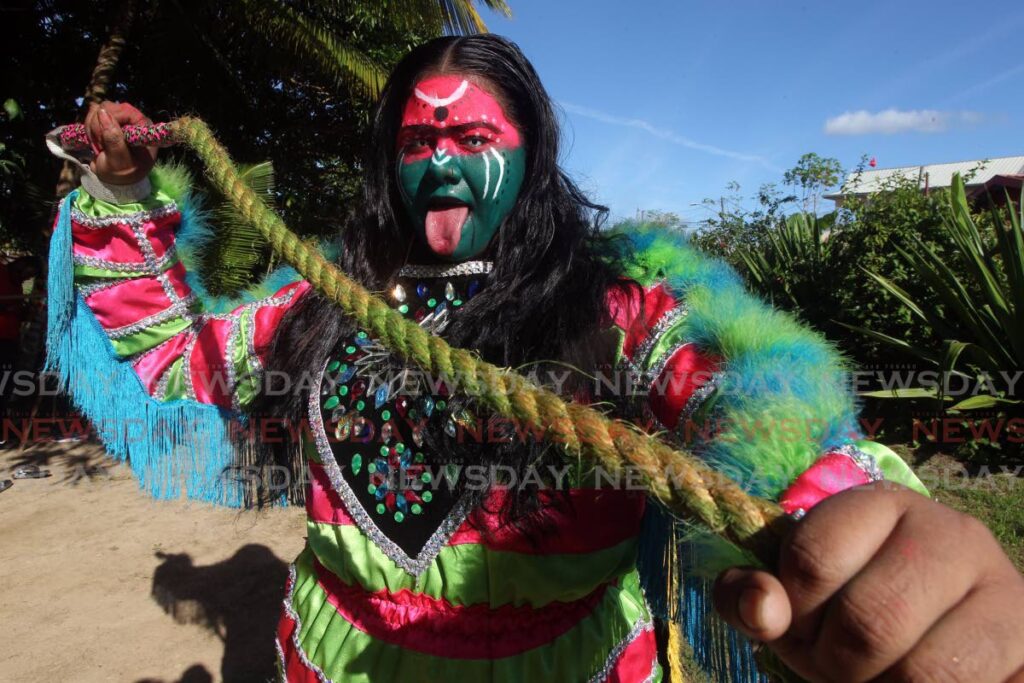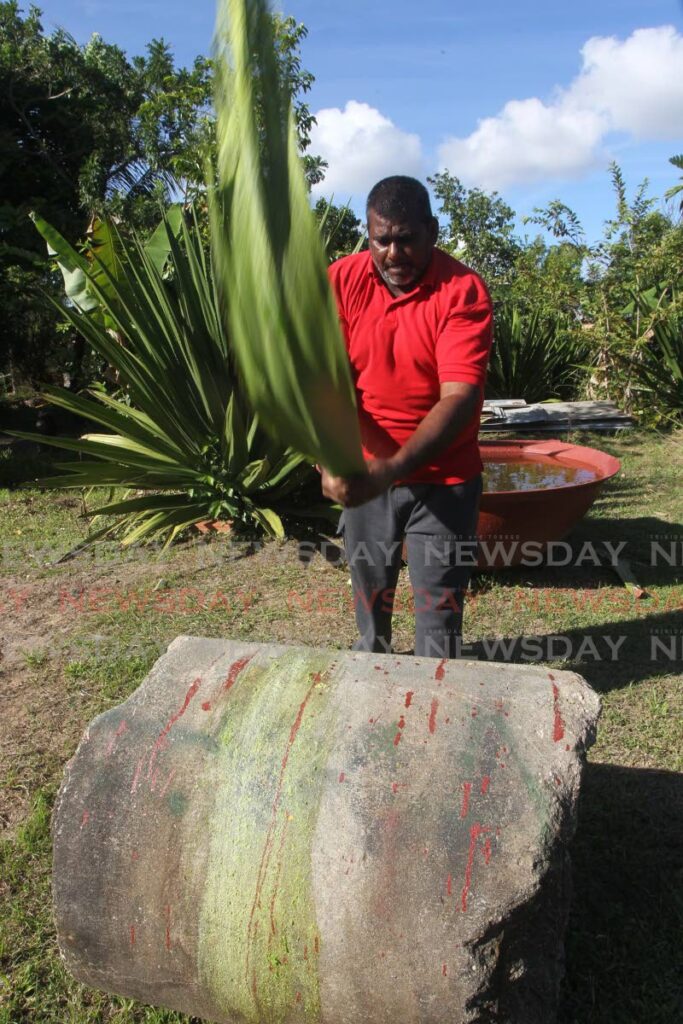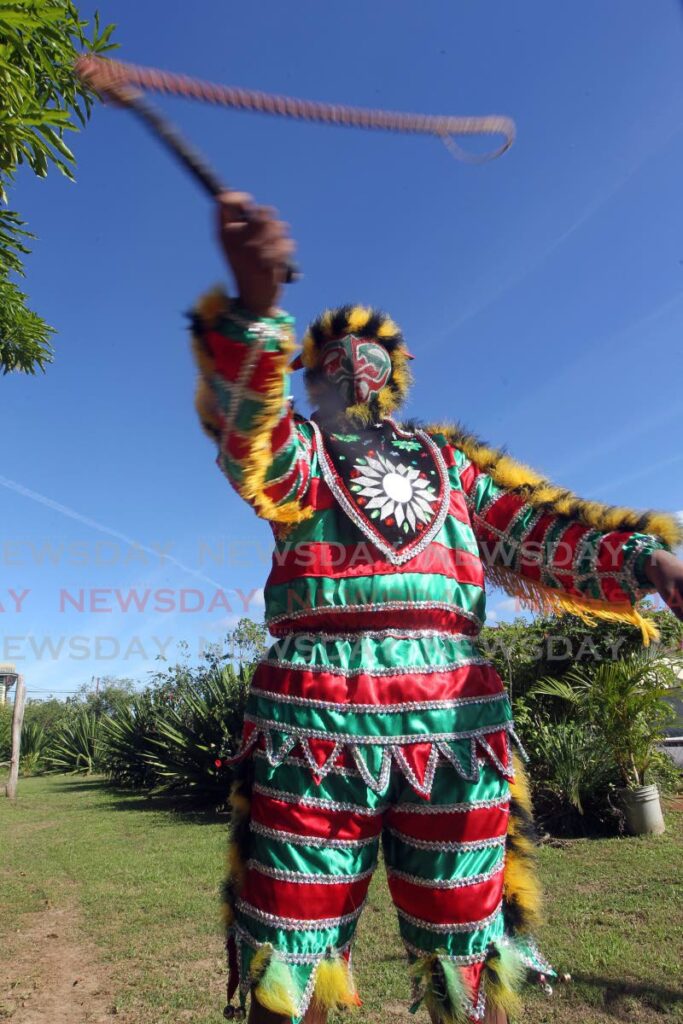Jab jab, a spiritual tradition in Carnival

The jab jab, or rope jab, is one of the most fearsome of TTs traditional Carnival characters. Although portrayed as ruthless fighters with cackling whips and intimidating masks, the practice is far more spiritual than most people realise.
King Jab Jab and manager of the First Citizens Original Jab Jab band Ronald Alfred, a third-generation player, has said he has watched helplessly over the years as entire bands from villages across the country have died out with no one to pass the tradition on to.
The Couva resident has been working to keep the tradition alive, teaching the techniques of the artform to a new generation.
“When I was young, we used to go all over the island and meet other jab jab bands,” said Alfred. “But as I continued over the years, I have been seeing less and less of them, until one day I went back to (one of) the villages and ain’t see nobody.”
Alfred said he was told by villagers that everyone in the band in that area had died out. Now, Alfred is more determined than ever to keep the tradition alive. “I broke the rules,” he said, about teaching others about jab jab.
“I was taught not to teach this to anybody (but) if I die without sharing this knowledge, it will be a waste.”

Certain moves were kept a secret in the past to give bands the upper hand when facing off with opposing bands.
Jab jab, said Alfred, is an indigenous form of martial arts that combines the traditions brought to the island by the East Indians during indentureship and the Africans before them during slavery.
Alfred said in the early years, the police would not allow jab jab fighting and those who practised it were feared and labelled dangerous.
“Carnival was an outlet for us to do our thing without being criticised and judged.” He said the preparation for Carnival begins long before Monday and Tuesday. Fighters would fast for 40 days from meat and alcohol and would perform Hindu Kali worship in a forested area where they have access to plants which help prepare their bodies for battle.
He said people were especially prejudiced against the spiritual aspect of the practice and those who did it were called demonic. Jab is the French patois for diable, meaning devil.
“We use the bush to strengthen the body to take lash. On the Carnival Sunday night, we do a spiritual bush bath and invite our ancestors who used to play. We invite them to be around us and play too. We bring them in for Carnival and then after Carnival, send them back.”
He said the rope jab, as he calls it, has many different styles reflective of the country’s East Indian and African heritage.
Alfred said traditionally, for Carnival, bands would meet each other in the street and kings would go head-to-head, battling each other with their whips and chants, known as lavway.
“We have different chants for different purposes. One chant may be to challenge a band. Hit them with your mouth before you hit them with your hand.”

An example of a lavway chant, said Alfred, would go, “We feeling evil (rope jab), We beatin’ people (rope jab), We seein’ red (rope jab) We ain’t ‘fraid to dead (rope jab).”
Alfred said although some interest in traditional characters like the jab jab is fading, he is still grateful it is more accepted now than it was in the past.
“For me, Carnival is my comfort zone. In society, that is where I was accepted. Long ago, we used to be criticised as evil, going in the cemetery and doing things.”
He said over the years he has been invited to lecture, through the National Carnival Committee (NCC), at the UWI and UTT’s creative arts and Carnival programmes.
“People who didn’t understand it before, now that avenues are more open, they accept it. They understand what it is about and not what people think it is. Now we are being respected and appreciated more.”
Alfred said his band has about 65 people and keeps growing. “It’s the way you do things as a leader. You have to know how to guide them. Know which bush to use.”
The once male-dominated tradition has grown to accept female members over the years. Alfred’s wife, Shalima Buckreedee-Alfred, was the first female jab jab in 1995. His father Winston Alfred was leader of the band at the time.
“She made a costume and was ready to go,” he joked. “She convinced them, and now more ladies are in the band. I get some good buff for that,” he said with a laugh. Now, his daughter is also a part of the band.
Alfred said the iconic cracking whip is made from the natural fibres of the green agave plant, known locally as the lash plant.
The leaves of the plant are beaten to get to the fibre. It is then treated with linseed oil, put to dry then plaited into the whip.

The fighting whip is also made from natural fibres of the cassava, or cascade plants. “Few jab jabs around know about these things. Long ago, they used cable (wire) whips. I don’t use that. That could kill somebody. I still have mine, but we don’t want to hurt anybody.”
He said jab jab battles in the past were taken seriously and could become violent, but are no no longer practised that way. “We teach (jab jab) in a disciplined manner now.”
He said the mask is also a unique reflection of each individual player.
“We make it ourselves. The painting of the masks, you won’t find that anywhere else in the world. Each player makes their own character. You are your own jumbie.”
He said even the fringe on the sleeves have a function. They are used to hide the hand movements from the jab jab’s opponent. Pieces of mirrors are also used to reflect light and distract the opponents. The mirrors are also used to ward off evil spirits.
“When you put it together it looks pretty and nice (but) every piece of the costume has a purpose.”


Comments
"Jab jab, a spiritual tradition in Carnival"